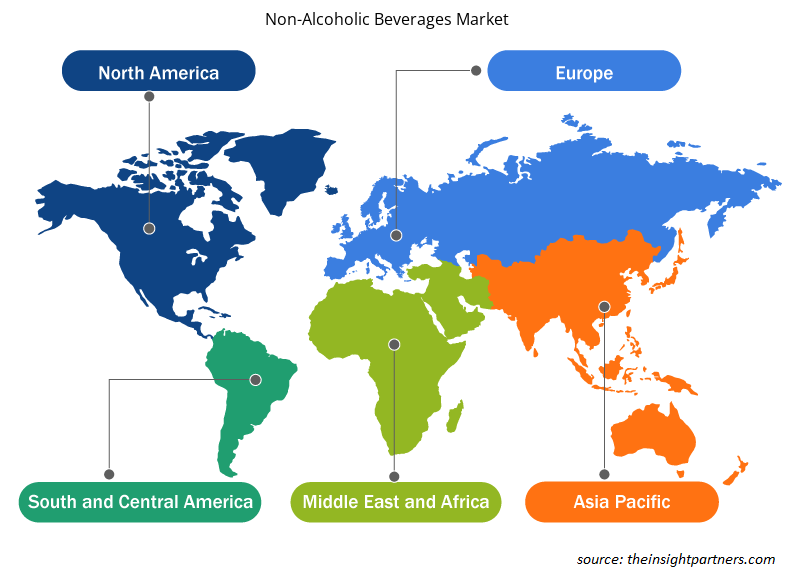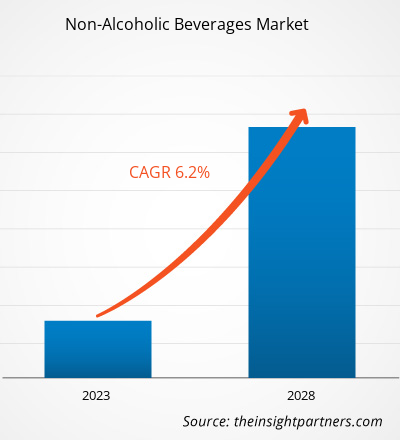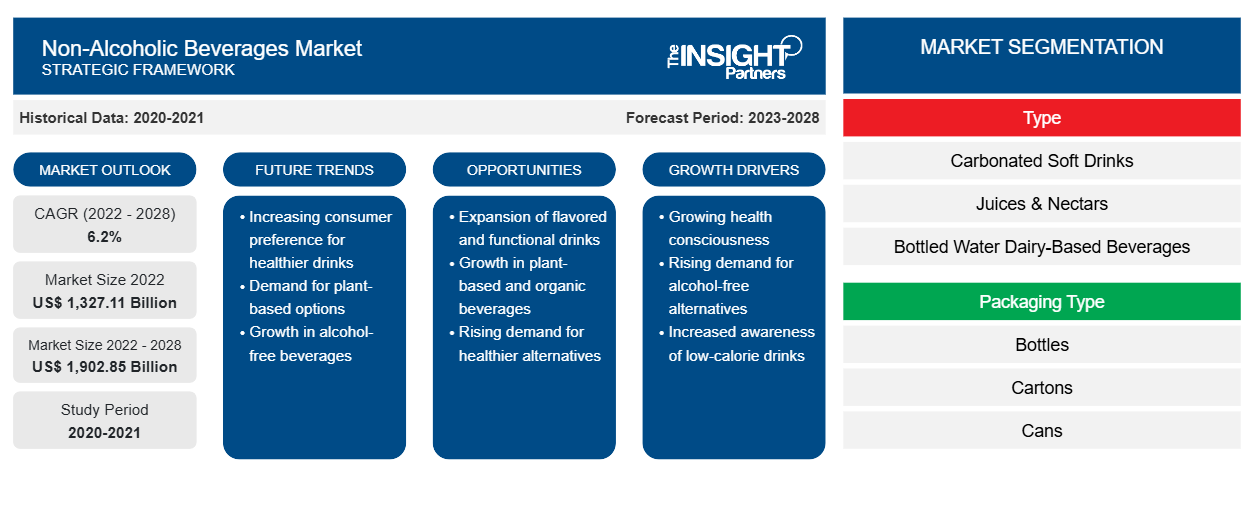ノンアルコール飲料の市場規模は、2022年の1兆3,271億1,000万米ドルから2028年には1兆9,028億5,000万米ドルに成長すると予想されています。2022年から2028年にかけて6.2%のCAGRで成長すると予測されています。
炭酸飲料、ボトル入り飲料水、ジュースやネクター、乳製品ベースおよび乳製品代替飲料、RTD ティーとコーヒー、エナジードリンクは、市場で入手可能なさまざまな種類のノンアルコール飲料です。世界中のさまざまな国で健康への関心が高まり、肥満、糖尿病、心臓病の有病率が高いため、無糖カテゴリは消費者の間で大きな注目を集めています。健康と栄養への関心が高まっているため、機能性飲料と強化飲料の需要が高まっています。アルコール飲料の消費に関する厳しい規制と、麦芽飲料がハラール認証を取得していることから、サウジアラビア、イラン、UAE などの中東諸国では、ノンアルコール麦芽飲料とプレミックスが広く消費されています。この要因により、世界のノンアルコール飲料市場におけるノンアルコール麦芽飲料セグメントの成長が促進されています。
2021年、アジア太平洋地域は世界のノンアルコール飲料市場で最大の収益シェアを占めました。アジア太平洋地域の市場を牽引する主な要因は、消費者の健康意識の高まり、代替乳製品飲料への高い需要、天然およびオーガニックフルーツジュースの人気の高まりです。日本や韓国などの国では、人口の大多数が乳糖不耐症です。この要因により、これらの国では乳製品代替飲料の人気が高まっています。さらに、アジア太平洋地域のノンアルコール飲料市場は、潜在的な消費者層の存在、健康的な飲料への強い需要、広範な小売環境により、収益性が高くなっています。NOLO(ノンアルコール/低アルコールビール、スピリッツ、カクテル)カテゴリーは、消費習慣の変化と健康的な食事と飲酒への消費者の関心の高まりにより、アジア太平洋地域で大きな需要を経験しています。そのため、ノンアルコールまたは低アルコールのビールやスピリッツを提供する多くの新興企業が、アジア太平洋地域全体に拠点を拡大しています。たとえば、ノンアルコールビール、スピリッツ、ワインのオンラインショッピングプラットフォームであるSipfreeは、2020年1月に香港で開始され、COVID-19の流行にもかかわらず、Sipfreeの売上は大幅に増加しました。このような拡大により、予測期間中のアジア太平洋地域のノンアルコール飲料市場の成長において有利な機会が生まれることが期待されます。
要件に合わせてレポートをカスタマイズする
このレポートの一部、国レベルの分析、Excelデータパックなど、あらゆるレポートを無料でカスタマイズできます。また、スタートアップや大学向けのお得なオファーや割引もご利用いただけます。
-
このレポートの主要な市場動向を入手してください。この無料サンプルには、市場動向から見積もりや予測に至るまでのデータ分析が含まれます。
COVID-19パンデミックによるノンアルコール飲料市場への影響
パンデミック前の時期、ノンアルコール飲料市場は主に健康飲料や外出先で飲む飲料の需要の高さに牽引されていました。しかし、2020年のCOVID-19の流行により、多くの業界が前例のない課題に直面しました。食品・飲料メーカーは、製造ユニットの閉鎖やサプライチェーンの混乱により、パンデミックの初期段階では成長が鈍化しました。しかし、消費者のライフスタイルの変化、健康的な食生活への嗜好の高まり、健康志向の人口の増加により、ノンアルコール飲料の需要が大幅に促進されました。消費者は植物ベースの飲料が従来のものよりも栄養価が高いと考えているため、大豆、アーモンド、ココナッツミルクなどの植物ベースの飲料の需要はパンデミック後に2倍に増加しました。2020年6月に発表されたミンテルのレポートによると、調査対象となった英国の消費者の25%が、パンデミックによりビーガン食が魅力的に思えることに同意しました。これらの要因は、ノンアルコール飲料市場の成長にプラスの影響を与えました。
健康とウェルネスのトレンドは、COVID-19の発生後に始まりました。消費者は健康を維持するために、ヨガ、ジョギング、サイクリングなどのさまざまなフィットネス活動に取り組んでいます。この要因により、今後数年間、特にエナジードリンクとスポーツドリンクの分野で、ノンアルコール飲料市場に大きな可能性をもたらすことが期待されています。
市場分析
スポーツドリンクの採用急増がノンアルコール飲料市場を牽引
栄養はスポーツパフォーマンスの向上に重要な役割を果たします。アスリートやスポーツ選手は、毎日のエネルギーと栄養素の需要を満たすために適切な栄養を摂取する必要があります。プロのアスリートやスポーツ選手だけでなく、多くの人が健康全般を維持するために日々の身体活動を行っています。近年、健康とウェルネスへの関心の高まりにより、フィットネス愛好家の数が増加しています。スポーツドリンクは、運動や身体活動中に失われた電解質、水分、エネルギーを補給します。これらのドリンクには通常、水分補給、グリコーゲン貯蔵の補充、運動後の疲労の遅延に役立つ炭水化物、カリウム、ナトリウム、マグネシウム、カルシウムが含まれています。健康とフィットネスへの関心の高まりとスポーツ愛好家の増加は、世界中でスポーツドリンクの販売を促進する主な要因です。したがって、スポーツドリンクの採用の増加は、ノンアルコール飲料市場を大幅に推進しています。
タイプインサイト
タイプに基づいて、世界のノンアルコール飲料市場は、炭酸飲料、ボトル入り飲料水、ジュースとネクター、乳製品ベースの飲料、乳製品代替飲料、RTD紅茶とコーヒー、ノンアルコールビール、麦芽飲料、その他に分類されています。ジュースとネクターセグメントは、スパークリングフルーツジュースとその他にさらに細分化されています。炭酸飲料セグメントは、2021年に世界のノンアルコール飲料市場で最大のシェアを占め、乳製品代替飲料セグメントは予測期間中に最速のCAGRで成長すると予想されています。炭酸飲料は、きれいな水、砂糖、天然甘味料または砂糖代替品(ダイエット飲料の場合)、カフェイン、人工香料成分、果汁濃縮物、防腐剤、着色料から作られた発泡性のノンアルコール飲料です。スプライト、コカコーラ、マウンテンデュー、モンスターは、世界的に有名なソフトドリンクブランドの一部です。炭酸飲料は、コンビニエンス ストア、スーパーマーケット、大型スーパーマーケット、自動販売機、映画館、ソーダ ショップ、オンライン小売店などで幅広く販売されています。消費者のライフスタイルの変化、可処分所得の増加、コンビニエンス フードや飲料の需要増加が、炭酸飲料セグメントの市場を牽引しています。
カテゴリーインサイト
カテゴリーに基づいて、世界のノンアルコール飲料市場は、無糖と従来型に分類されています。2021年には、従来型セグメントがより大きな市場シェアを占めました。肥満、糖尿病、高血圧、心血管疾患の増加により、無糖飲料の需要が高まっています。国際糖尿病連合によると、2021年には世界中で約5億3,700万人が糖尿病を患っていました。多くの飲料メーカーは、無糖飲料の需要の高まりに対応するために、天然の低カロリー甘味料を使用した製品を積極的に開発しています。この要因がこのセグメントの市場を牽引しています。
ノンアルコール飲料市場の地域別分析
予測期間を通じてノンアルコール飲料市場に影響を与える地域的な傾向と要因は、Insight Partners のアナリストによって徹底的に説明されています。このセクションでは、北米、ヨーロッパ、アジア太平洋、中東、アフリカ、南米、中米にわたるノンアルコール飲料市場のセグメントと地理についても説明します。

- ノンアルコール飲料市場の地域別データを入手
ノンアルコール飲料市場レポートの範囲
| レポート属性 | 詳細 |
|---|---|
| 2022年の市場規模 | 1兆3,271億1,000万米ドル |
| 2028年までの市場規模 | 1兆9,028億5,000万米ドル |
| 世界のCAGR(2022年 - 2028年) | 6.2% |
| 履歴データ | 2020-2021 |
| 予測期間 | 2023-2028 |
| 対象セグメント |
タイプ別
|
| 対象地域と国 |
北米
|
| 市場リーダーと主要企業プロフィール |
|
ノンアルコール飲料市場のプレーヤー密度:ビジネスダイナミクスへの影響を理解する
ノンアルコール飲料市場は、消費者の嗜好の変化、技術の進歩、製品の利点に対する認識の高まりなどの要因により、エンドユーザーの需要が高まり、急速に成長しています。需要が高まるにつれて、企業は提供品を拡大し、消費者のニーズを満たすために革新し、新たなトレンドを活用し、市場の成長をさらに促進しています。
市場プレーヤー密度とは、特定の市場または業界内で活動している企業または会社の分布を指します。これは、特定の市場スペースに、その規模または総市場価値と比較して、どれだけの競合相手 (市場プレーヤー) が存在するかを示します。
ノンアルコール飲料市場で事業を展開している主要企業は次のとおりです。
- コカコーラ社
- ペプシコ
- ネスレ
- レッドブル
- サントリーホールディングス株式会社
免責事項:上記の企業は、特定の順序でランク付けされていません。

- ノンアルコール飲料市場のトップキープレーヤーの概要を入手
世界のノンアルコール飲料市場で活動している主要企業には、コカコーラ、ペプシコ、ネスレ、レッドブル、サントリーホールディングス、ダノンSA、カリフィアファームズLLC、キューリグドクターペッパー、アサヒグループホールディングス、ボルトハウスファームズ、ハイネケンNV、クールバーグビバレッジズPvt Ltd、ゴヤフーズ、アンハイザー・ブッシュ・インベブNV、カールスバーグASなどがあります。世界のノンアルコール飲料市場で活動している企業は、変化する消費者のニーズを満たすために、新しいフレーバーのオーガニック、GMOフリー、植物ベース、グルテンフリーの製品を提供することに注力しています。たとえば、2019年にコカコーラユーロパシフィックパートナーズは、オネストオーガニックレモネードシリーズに2種類のスパークリングジュースを発売しました。この製品はオーガニックフルーツジュースと砂糖から製造されており、甘味料や人工香料は含まれていません。このような革新的な製品は消費者の大きな支持を得て、ノンアルコール飲料市場の成長を促進すると予想されます。
レポートの注目点
- ノンアルコール飲料市場における進歩的な業界動向は、プレーヤーが効果的な長期戦略を策定するのに役立ちます。
- 先進国市場と発展途上国市場で採用されているビジネス成長戦略
- 2020年から2028年までのノンアルコール飲料市場の定量分析
- ノンアルコール飲料の世界需要の推定
- 業界で活動するバイヤーとサプライヤーの有効性を示すポーターの5つの力の分析
- 競争市場の状況を理解するための最近の動向
- 市場動向と見通し、およびノンアルコール飲料市場の成長を牽引・抑制する要因
- 商業的利益の基盤となる市場戦略を強調し、市場の成長につながる意思決定プロセスを支援する
- ノンアルコール飲料市場の規模
- 市場の詳細な概要とセグメンテーション、およびノンアルコール飲料業界の動向
- 有望な成長機会のあるさまざまな地域のノンアルコール飲料市場の規模
- 過去2年間の分析、基準年、CAGRによる予測(7年間)
- PEST分析とSWOT分析
- 市場規模価値/数量 - 世界、地域、国
- 業界と競争環境
- Excel データセット
最新レポート
関連レポート
お客様の声
購入理由
- 情報に基づいた意思決定
- 市場動向の理解
- 競合分析
- 顧客インサイト
- 市場予測
- リスク軽減
- 戦略計画
- 投資の正当性
- 新興市場の特定
- マーケティング戦略の強化
- 業務効率の向上
- 規制動向への対応























 無料サンプルを入手 - ノンアルコール飲料市場
無料サンプルを入手 - ノンアルコール飲料市場